Zebra and quagga mussels: Tiny but terrifying invaders
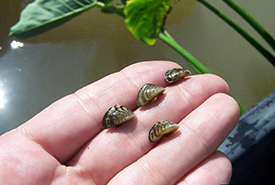
Zebra mussels (Photo by Michael Massimi, Barataria-Terrebonne National Estuary Program/Bugwood.org)
As motivated and concerned members of the community, there are countless opportunities to reduce our carbon footprint, protect habitat and conserve biodiversity. Invasive species are just one piece of the puzzle, and the good news is that preventing their spread can be easy!
As summer comes into full swing, there’s no better time than now to talk about aquatic invasive species that threaten the lakes and rivers we love to swim, boat and fish in.
When it comes to aquatic invaders in Canada, the list is long. In fact, in the Great Lakes alone there are over 180 invasive and non-native species. Many of these species disrupt food webs and outcompete native species.
But what are arguably two of the most threatening invasive species in Canadian waters also happen to be two of the tiniest.
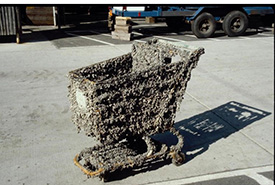
Zebra mussel-encrusted shopping cart (Photo by James F. Lubner)
At an average length of 2 to 2.5 centimetres, the zebra mussel is quick to conquer the aquatic ecosystems it invades. Zebra mussels originally hail from southeastern Europe, having arrived in the late 1980s, likely in the ballast water of cargo ships. Most zebra mussel populations in Canada are concentrated in southern Ontario, including the Great Lakes, with some populations extending into Quebec and Manitoba. Since their arrival, zebra mussels have spread throughout connected waterways naturally, and into new waterbodies by attaching to hulls of boats. It doesn’t help that zebra mussels release up to 1 million eggs per season!
Related blog posts
The quagga mussel, the zebra mussel's slightly larger and rounder invasive relative, arrived and spread in Canada in very similar ways. In areas where both species are present, quagga mussels are able to outcompete zebra mussels due to their ability to colonize soft substrates and survive in areas with low food.
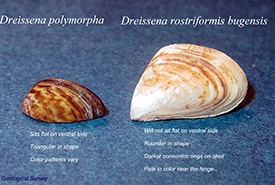
Zebra mussel (left) compared to the quagga mussel (right; Photo by USGS)
After arriving in a waterbody, invasive mussels wreak havoc in several ways. They are filter feeders, which means they eat tiny phytoplankton in the water. This filter feeding decreases the food sources available for native species (disrupting the food web) and increases the clarity of the water. This means more sunlight, which, in turn, can result in more algal blooms, which negatively impact the ecosystem.
These tiny invaders with sharp edges attach to and smother native freshwater mussels, clog intake pipes and coat beaches, docks and shallow waters; creating a hazard for swimmers.
Despite their distribution in central Canada, there are still many areas that haven’t been invaded by zebra and quagga mussels, and we can all contribute to keep it that way.
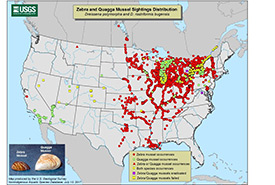
Zebra and quagga mussel distribution (Photo by USGS)
One of the best actions you can take is to clean, drain and dry your boat each time you move it from one waterbody to another. This means cleaning your boat with high heat or high-pressure water, manually removing any mud, organisms and plant material, and draining any lingering water (such as from live wells and bilges) that may have microscopic invasive mussel juveniles lurking within. Several provinces also have mandatory boat inspection stations and regulations to protect Canadian waters. As a bonus, these actions can help prevent the spread of other invasive species — not just zebra and quagga mussels!
Learn more about how to properly clean your boat here.
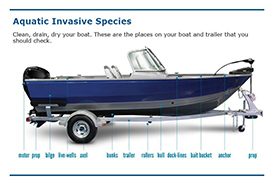
Areas to target when cleaning your boat. (Photo by the Government of Alberta)
When it comes to invasive species, we all have a responsibility for taking the small steps necessary to prevent their spread. When we clean, drain and dry our boats, we protect our favourite waterbodies from invasion and ensure that future generations can experience the same joy out on the water that we did. These actions protect native wildlife, keep our secret fishing spots healthy and preserve our beloved lakeside camping spots.
So while you’re out this summer enjoying the natural beauty Canada has to offer, keep zebra and quagga mussels in mind. Every action you take to prevent their spread makes a difference!
If you think you’ve seen invasive mussels or another invasive species, report your sighting! Learn more about zebra mussels and quagga mussels here.
You can find more information about aquatic invasive species here. Learn more about invasive species threatining Canada's natural spaces by signing up to receive bi-weekly email updates on recent invasive species media and research, information on upcoming events and a quarterly newsletter from the Invasive Species Centre.


